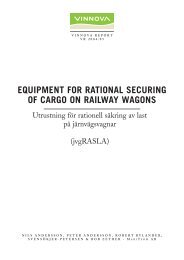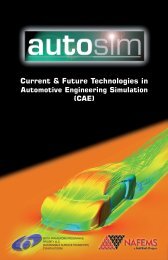WP3: Rail Passenger Transport - TOSCA Project
WP3: Rail Passenger Transport - TOSCA Project
WP3: Rail Passenger Transport - TOSCA Project
Create successful ePaper yourself
Turn your PDF publications into a flip-book with our unique Google optimized e-Paper software.
In most cases it is assumed that the GHG content of the electricity mix is as in 2009 (128<br />
gCO 2 -eq per MJ el), except for scenario 8, where it is assumed to be reduced by 80 % by 2050.<br />
Scenario 8 is just an example, as the GHG content of electricity is a scenario variable of Stage<br />
2 of Tosca. GHG emissions from diesel trains are direct emissions (75 gCO 2 -eq per MJ fuel),<br />
assumed to use fossil fuels only.<br />
Table 5-3a<br />
Energy use and GHG emissions (per passenger-km) by technology, as an<br />
average over intercity, regional and city passenger trains, estimated for new<br />
trains by 2050 compared with reference trains, at public grid or fuel tank.<br />
Most<br />
likely<br />
Energy Use<br />
(MJ / pass-km)<br />
LB<br />
UB<br />
GHG Emissions<br />
(g CO 2 -eq / pass-km)<br />
Most<br />
likely<br />
Reference electric trains (2009) 0.368 47<br />
1. PA Low-drag 0.334 0.32 0.35 43 41 45<br />
2. PB Low-mass 0.343 0.33 0.36 44 42 46<br />
3. PC Energy recovery 0.313 0.29 0.33 40 37 41<br />
4. PD Space efficiency 0.314 0.30 0.34 40 38 42<br />
5. PF Eco-driving 0.310 0.29 0.33 40 37 41<br />
6. Pcomb electric (incl. incremental) 0.157 0.13 0.19 20 17 24<br />
7. Pcomb HS: As (6) + higher speed 0.187 0.16 0.23 24 20 29<br />
8. As 7. + low-GHG electric mix 0.187 0.16 0.23 5 4 6 a<br />
LB<br />
UB<br />
Reference diesel train (2009) 0.75 54<br />
9. Pcomb diesel 0.37 0.34 0.43 27 25 32<br />
a<br />
With the GHG content of average electricity reduced by 60 % (instead of 80 % as assumed tentatively) the<br />
resulting GHG emissions are estimated to 8–11 gCO 2 -eq per net-tonne-km. The different scenarios presented in<br />
<strong>TOSCA</strong> WP6 are approximately within the range of 60–80 % reduction.<br />
Note that diesel trains by 2050 in Table 5-3a seem to be almost as good as the average electric<br />
train, assuming that GHG content of electricity is the same as in 2009. This will however not<br />
be the case if the average carbon content of European electricity is reduced. Another important<br />
aspect is that the average speed of electric trains by 2050 is 60 % higher than for diesel trains,<br />
which makes such a comparison inappropriate.<br />
Deliverable D4 – <strong>WP3</strong> passenger 21
















